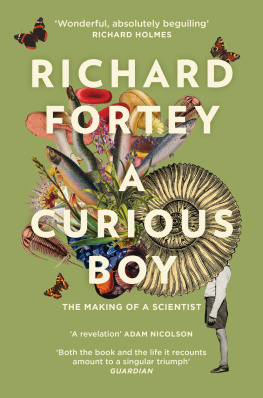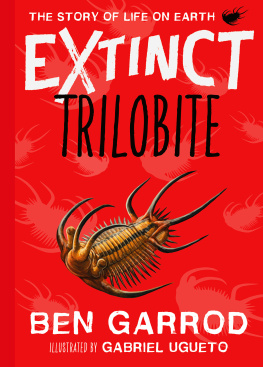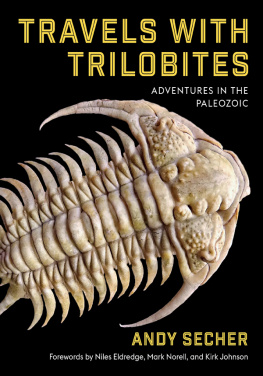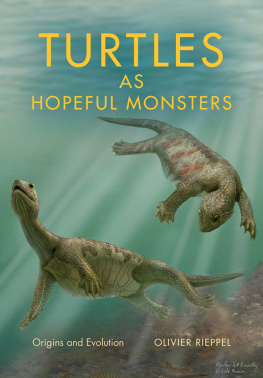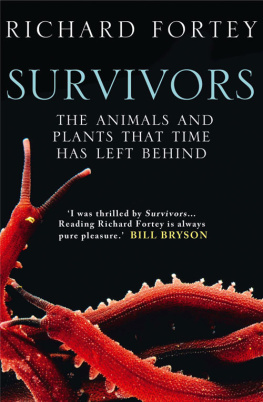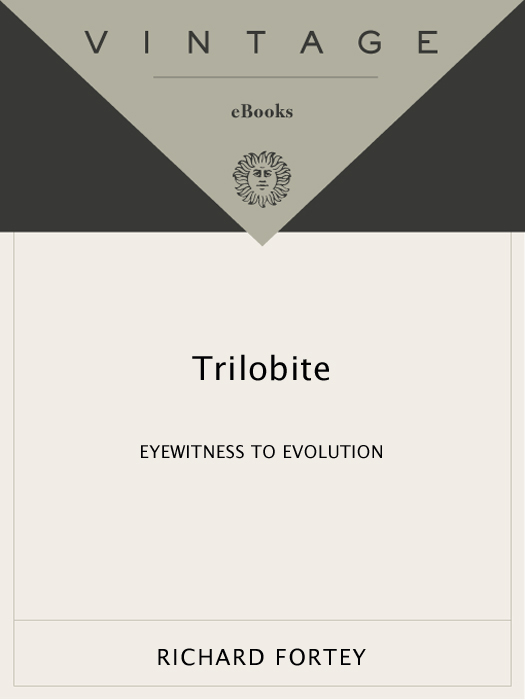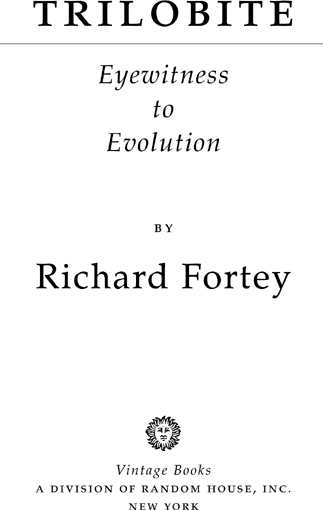With unabashed enthusiasm for his tiny armadillo-resembling subjects, Fortey offers this riveting, in-depth look at trilobites [and] the grand tale of our geologic past.
In Richard Forteys capable hands the humble trilobite has been transformed into the E.T. of the Lower Palaeozoica lovable and highly instructive animal, amply deserving of the enthusiasm and affection with which it is memorialized in this remarkable and fascinating book.
Fortey is a gifted writer who shares his knowledge with grace and verve. But the deeper message of Trilobite is about seeing and the search for truth.
This is the way science should be written: so engagingly that it makes you forget that youre actually learning something (actually, youre learning a lot), and carrying you swiftly from page to page. Filled with insight, science, history, charm and wit.
Forteys books are always a treat. Its not just that they are beautifully written his vision is wonderfully humane. And you cant say that for many science writers.
Richard Fortey is a senior paleontologist at the Natural History Museum in London. He is the author of several books, including Fossils; The Hidden Landscape, which won the Natural World Book of the Year in 1993; and Life, which was short-listed for the Rhne-Poulenc Prize in 1998. He is a Fellow of the Royal Society.
ALSO BY RICHARD FORTEY
Fossils: The Key to the Past
The Hidden Landscape
Life: A Natural History of the First Four Billion
Years of Life on Earth
For my mother
Contents
I
II
III
IV
V
VI
VII
VIII
IX
X
Illustrations
Plates
SECTION ONE
. Dr. Lhwyds flatfish, now known as Ogygiocarella debuchii.
. Silicified trilobite headshields.
. Bumastus.
. Radiaspis, a fantastically spiny trilobite from the Devonian rocks of Morocco.
. Dalmanites, one of the first trilobites to be discovered.
. X-ray of Phacops.
. Olenoides serratus from the Cambrian Burgess Shale.
. Hypermecaspis, showing small headshield and long thorax.
. Graveyard of Leptoplastides.
. Olenellus, one of the oldest trilobites from the Lower Cambrian rocks.
. Tiny, blind Agnostus pisiformis.
. The elegant Isotelus from the Ordovician of New York State.
. Blind, medallion-like trilobite Trinucleus fimbriatus.
. Head of trilobite Protolloydolithus, related to Trinucleus.
. Giant-eyed trilobite Pricyclopyge.
. Silurian trilobite Calymene, from Gotland, Sweden.
. Antique gold brooch with Calymene as the centrepiece.
. Lateral view of perfectly preserved enroled Phacops.
SECTION TWO
. Crotalocephalus.
. Acanthopyge, a trilobite the size of a crab.
Thysanopeltis, a relative of Scutellum.
. Cluster of five Cyphaspis.
. Griffithides, from Carboniferous rocks of Indiana.
. Paraharpes.
. Cnemidopyge, a close relative of Ampyx.
. Three blind trilobites, Conocoryphe.
. A strawberry-headed trilobite of the Silurian period, Balizoma variolaris.
. Pagetia, a diminutive, flea-sized trilobite.
. Selenopeltis, with enormously elongated genal spines.
. Moulted, cast-off exoskeleton of Leonaspis.
. Sao hirsuta from the Cambrian of Bohemia.
. A plate from Barrandes magnificent work on the trilobites of Bohemia.
. A piece of Cambrian swallow stones from Shandong, China.
. Fantastically spiny trilobite Comura, from the Devonian of Morocco.
References in the text to figures refer to images reproduced in the plate sections.
Preface
I have been enthralled by trilobites for more than thirty years. This book is both my homage to them, and an attempt to convey to others something of the pleasure that their study has given to me. In the process, something of the scientific method may be revealed. My last book was a biography of all life, from bacterium to mankind, in which the trilobites were passed over in a page or two. Now I have the chance to turn the focus the other way and to allow my favourite animals to tell their stories in the detail they deserve. Even so, I am as conscious of what I have had to leave out as of what I have been able to include. History can never be told completely, and three hundred million years of history is bound to be more of a prcis than a narrative. I wish to persuade the reader of the excitement of recreating vanished worlds, and of seeing ancient seas through the eyes of the trilobites. This is not an academic study, rather, it is an incitement to discovery.
London, October 1999
I
Discovery
Out of season, the bar of the Cobweb Inn at Boscastle is everything a pub should be. There is a low, heavily-beamed ceiling hung with antique bottles, and a plain floor which is a jigsaw of flagstones. Photographs of the local womens darts team hang on the wall, alongside framed, faded newspaper cuttings which record in print the several virtues of the inn. A log fire gives out rather more heat than is needed. There is no music save the low buzz of rich vernacular; in November, no Londoner ventures to the North Cornwall coast. The Cobweb is a slightly scruffy, comfortable old place, where you can talk if you need to, but if you feel like saying nothing you can just watch the flames in the hearth, and nobody will think you odd if a smile plays on your lips. It takes an effort of will to leave the dark, comfortable, nourishing womb of the inn, and emerge, blinking, into the bright world outside; but leave I must, because I have to find Beeny Cliff before the light fades. It can be dangerous out on the cliffs after nightfall.
Boscastle is tucked into a cleft on the wild northern coast of the long peninsula that completes south-west England, and it is built around a narrow harbour where the River Valency cuts down to the sea. It is an ancient place, where the cosmetics of the tourist tradeWitchcraft Museum and knick-knack shopshave not quite succeeded in smothering a character that was born of slate and hardship. At one time the town comprised almost nothing but inns serving miners and seamen, of which the Cobweb is a survivor, and you can still imagine a dozen different signs advertising their wares all along the crooked street that leads to the haven. The houses are former inns, prettified with features that fail to disguise their boozy origins. The rough local stone gives the buildings their character. Even the Witchcraft Museum is a cottage with an ancient roof that sags crazily under the weight of Cornish slates. On this day the harbour is almost deserted, and I can imagine the place as it must have looked when the poet and novelist Thomas Hardy visited it as a young man, more than a century ago.





